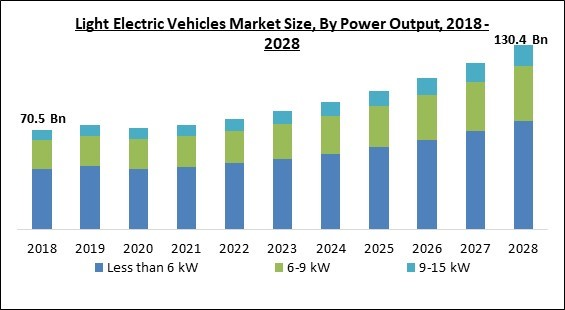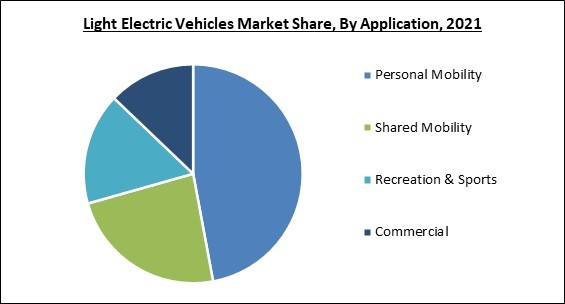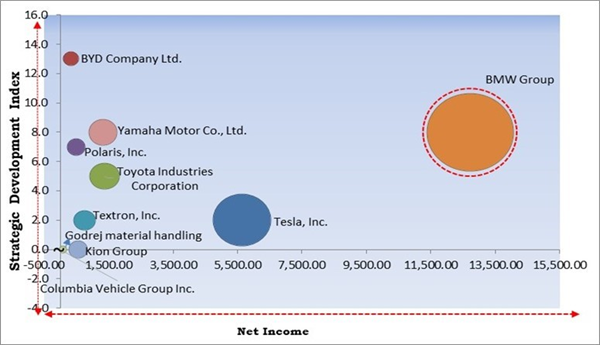The Global Light Electric Vehicles Market size is expected to reach $130.4 billion by 2028, rising at a market growth of 8.9% CAGR during the forecast period.
Light electric vehicles (LEV) consisting of two- and three-wheeled electric cars are the largest segment of electric vehicles in terms of stock. These vehicles will be at the center of electrification initiatives in China, India, and other Asian nations, where their conventional counterparts are favored for last-mile connection and are seen as a cost-effective means of personal transportation.
Due to the usage of lead-acid batteries, these cars were historically charged slowly. The adoption of new chemistry makes faster charging possible, but thermal control remains the greatest obstacle. On the other side, battery changing is an option that can help reduce the battery charging time.
A vehicle driven by one or more electric engines is an electric vehicle (EV). It can be fueled externally by a collector system or autonomously by a battery. EVs include road and rail vehicles, surface and underwater watercraft, electric airplanes, and electric spacecraft, among others.
EVs initially appeared in the late 19th century, when electricity was one of the preferred ways for motor vehicle propulsion, offering a level of comfort and ease of operation that gasoline cars of the period could not match. Approximately 100 years ago, internal combustion engines dominated the propulsion of automobiles and trucks, but electric power remained prevalent in trains and smaller vehicles of all sizes.
COVID-19 Impact Analysis
Several COVID-induced market shifts may have a negative influence on the EV transition. Falling global crude oil prices have been one of the first casualties of the economic downturn. Low oil prices at the pump undermine the economic viability of EV adoption relative to combustion vehicles, particularly in nations with limited EV fiscal incentives. If oil prices worldwide remain at current levels, the considerably higher total cost of ownership for EVs may impede the changeover. Supply chain disruptions pose a further significant threat to EV adoption. China is the major provider of EV manufacturing ecosystem components. In such a scenario, the transition trajectory will differ from country to country, depending on each nation's capacity to create an indigenous supply chain within a specified timeframe.
Market Growth Factors
Constantly Rising Gasoline And Diesel Prices
In recent years, the demand for fuels such as gasoline and diesel has expanded dramatically due to the rising need for vehicles. The most recent increase in fuel prices is due to the price increase of crude oil, which is used to produce gasoline and diesel. At the outset of the COVID-19 pandemic, crude oil was less expensive due to the temporary closure of a large number of businesses and a fall in energy demand. As life resumed its usual path, the energy demand soared. However, expenses have climbed dramatically as a result of suppliers' challenges in meeting consumers' rising demands.
Increasing Use Of Electric Vehicles
Electric vehicles have several advantages, such as lower operating costs than conventional gasoline engines, the execution of strict government regulations to reduce environmental pollution, and a reduction in tailpipe emissions, all of which have a significant positive effect on their global demand. To capitalize on the market opportunity, key market players for electric car power inverters are implementing a variety of strategic initiatives, including product development and product launch. For example, ABB Ltd. released an all-in-one electric vehicle charger with the fastest charging speed on the market.
Market Restraining Factors
Levs have a shorter range and higher initial cost of ownership than ice vehicles
Due to range restrictions, the expansion of the Light electric vehicle market has been restricted. LEVs lack fuel tanks for energy storage and easy refueling, unlike ICE vehicles. A fully charged battery has a restricted range, which is often less than that of its internal combustion engine counterpart. Currently, the majority of electric two-wheelers, such as e-scooters, e-motorcycles, and e-bikes, have a range of 100-120 miles and a charge time of 6-8 hours. As a result, consumers who travel more than 100 miles per day are hesitant to invest in LEVs.
Vehicle category Outlook
Based on the Vehicle category, the Light Electric Vehicles Market is segmented into 2-wheelers, 3-wheelers, and 4-wheelers. The 2-wheelers segment acquired the highest revenue share in the light electric vehicles market in 2021. Two-wheeled vehicles obtain their electricity from a battery and an alternator. The purpose of the battery is to store charge; it also maintains a specified voltage level and keeps the electrical system operational when the engine is turned off.
Application Outlook
On the basis of Application, the Light Electric Vehicles Market is divided into Personal Mobility, Shared Mobility, Recreation & Sports, and Commercial. The shared mobility segment recorded a substantial revenue share in the light electric vehicles market in 2021. With increasing environmental concerns, traffic congestion, and a preference for autonomous driving, the market for shared mobility is anticipated to grow steadily. Shared mobility refers to the collective use of a vehicle for transportation by commuters who do not own it.
Power Output Outlook
By power output, the Light Electric Vehicles Market is classified into Less than 6 kW, 6-9 kW, and 9-15 kW. The less than 6 kW segment garnered the highest revenue share in the light electric vehicles market in 2021. For personal commuting and shared mobility applications, the increased demand for LEVs with modest seating capacity is projected to increase sales of electric scooters and electric cycles with low power (less than 6 kW). Due to their huge demand, Chinese manufacturers ship these low-power LEVs to North America and Europe at comparatively reduced prices.
Vehicle type Outlook
On the basis of Vehicle type, the Light Electric Vehicles Market is segmented into e-scooter, e-ATV/UTV, Neighborhood Electric Vehicle, e-bike & Motorcycle, e-lawn Mower, Autonomous Forklifts, Delivery Robots & Electric Industrial Vehicle, and Others. The e-bike & motorbike segment recorded a significant revenue share in the light electric vehicles market in 2021. An electric bicycle (e-bike, eBike, etc.) is a pedal-assist bicycle with an integrated electric motor. There are numerous types of e-bikes on the market, but they mainly fall into two categories: pedelecs and e-bikes with throttles and moped-like functions.
Component Type Outlook
Based on the component Type, the Light Electric Vehicles Market is bifurcated into the Battery Pack, Electric Motor, Motor Controller & Power Controller, Inverters, e-brake Booster & Power Electronics. The electric motor segment witnessed a substantial revenue share in the light electric vehicles market in 2021. Electric Propulsion (EP) is a type of space propulsion that employs electrical power to accelerate a propellant through a variety of electrical and/or magnetic mechanisms. Compared to typical chemical thrusters, the performance of EP thrusters is enhanced by the use of electrical power.
Regional Outlook
Region-wise, the Light Electric Vehicles Market is analyzed across North America, Europe, Asia Pacific, and LAMEA. The Asia Pacific segment garnered the largest revenue share in the light electric vehicles market in 2021. APAC is considered to have the largest market for light electric vehicles due to the region's rapid urbanization and the consequent need for environmentally friendly and cost-effective transportation solutions. Government initiatives and subsidies also promote regional market expansion as a means of mitigating the rising pollution levels of industrial economies, particularly China and India.
The Cardinal Matrix - Light Electric Vehicles Market Competition Analysis
The major strategies followed by the market participants are Partnerships. Based on the Analysis presented in the Cardinal matrix; BMW Group is the major forerunner in the Light Electric Vehicles Market. Companies such as Tesla, Inc., Toyota Industries Corporation and Yamaha Motor Co., Ltd. are some of the key innovators in the Light Electric Vehicles Market.
The market research report covers the analysis of key stake holders of the market. Key companies profiled in the report include Tesla, Inc., BMW Group, Columbia Vehicle Group Inc. (Nordic Group of Companies, Ltd.), Godrej Group (Godrej Material Handling), Kion Group, Yamaha Motor Co., Ltd., Textron, Inc., Polaris, Inc., BYD Company Ltd., and Toyota Industries Corporation.
Strategies Deployed in Light Electric Vehicles Market
Partnerships, Collaborations and Agreements:
- Aug-2022: BYD joined hands with Castrol, a British oil company. Under this collaboration, the Castrol ON advanced EV fluids would be utilized in BYD’s growing range of electric vehicles. Additionally, with the ending of manufacturing of internal combustion engine (ICE) vehicles, Castrol would go towards supporting BYD boosting EV adoption around the world.
- Aug-2022: BYD came into a partnership with Orix, a Japanese diversified financial service. Through this partnership, the companies aimed to introduce the e6 electric vehicle within 5 cities in India, the first high-end electric, and the first and only variant to utilize the Blade Battery. Additionally, with the all-new e6, BYD is excited to begin the electric vehicle fleet procedure with the shared value of eco-friendly development.
- Aug-2022: Tesla signed an agreement with Zhejiang Huayou Cobalt along with CNGR Advanced Material. This agreement aimed to manufacture and markets new materials, marked pricing agreements with the electric-vehicle giant for supplies until the middle of this decade, as per to divide stock-exchange announcements from the parties.
- Jul-2022: Yamaha Motors formed a partnership with FullFily, an all-electric sustainable energy-powered EV vehicle business. Together, the companies aimed to utilize their’ strategic partnerships to enhance the access of fleet and infrastructure for tier 2/3 markets and the SMB space which is harshly under-serviced. Moreover, companies aimed to improve shared mobility utilization and develop employees.
- May-2022: BYD came into the partnership with Charge zone along with Volttic and Indipro. This partnership aimed to manage the re-charging requirements of the All-New e6.
- Mar-2022: Textron Ground Support Equipment joined hands with General Motors along with Powertrain Control Solutions. Through this collaboration, the GM and PCS have developed a combined driveline that leverages GM's lithium-ion battery systems. Moreover, Textron GSE would be capable to help from GM's experience in electric propulsion systems due to the driveline.
- Mar-2022: BYD signed an agreement with Shell, a British multinational oil and gas company. This agreement aimed to enhance charging accessibility for battery electric vehicle (BEV) and plug-in hybrid electric vehicle (PHEV) owners. Moreover, companies would deliver combined home energy products including dynamic tariff scheduling, home batteries, solar integration, and Vehicle-to-Grid (V2G) charging.
- Feb-2022: Polaris came into a partnership with Wallbox, a smart electric vehicle charging, and energy management provider. Through this partnership, Polaris would sell the 40 Amp model of Wallbox's best-selling charger, the Pulsar Plus, in order to produce it even quicker for a consumer to charge their electric vehicles. Additionally, Off-road vehicles are a perfect fit for Pulsar Plus 40 Amp because of its NEMA connection, which presents greater versatility for agricultural and rural charging locations.
- May-2021: BYD teamed up with LEVO, a network for millennials in the workplace. Through this collaboration, the companies aimed to utilize Nuvve’s technology and stone peaks and grow capital via Levo to deliver fully invested, V2G-compatible BYD medium and heavy-duty electric fleet vehicles. Moreover, The BYD-Levo collaboration has the prospect to boost and develop the transportation industry at a crucial time.
- Dec-2021: BMW partnered with TVS, an Indian multinational motorcycle manufacturer. Together, the companies aimed to produce a range of EV two-wheelers for both partners varying from scooters to motorcycles and even new designs. Moreover, the companies would together create a new platform and future technologies, such as electric vehicles.
- Sep-2020: Polaris partnered with Zero Motorcycles, a global leader in electric motorcycle powertrains and technology. Through this acquisition, Polaris aimed to Co-Develop Electric Vehicles as a Cornerstone of rEV’d up to position Polaris as the Powersports EV authority and present consumers with an electric vehicle option within each of its core products. Moreover, this partnership would allow leapfrogging technological limitations around range and cost while delivering a tremendous speed-to-market benefit and an immediate offense.
Product Launches and Product Expansions:
- Oct-2022: Polaris launched Arctic MRZR and All-Electric RANGER XP, a fully-enclosed cab. The cabs are developed to be adapted to any Polaris MRZR Alpha version such as the wheeled or used with tracked kit version. Moreover, the cab delivers a quickly available solution that would contribute to fulfilling on-base sustainability conditions for zero emissions at a bit of the cost of full-size electric trucks.
- Oct-2022: BYD introduced BYD ATTO 3, a C-segment SUV, developed with the European consumer in mind. The BYD TANG is a 7-seater with varying all-wheel drive and the sleek and sporty sedan BYD HAN. Moreover, BYD has focused on dominating advanced technologies electronic control systems, electric motors, spanning batteries, and semiconductor chips.
- Apr-2022: Yamaha launched NEO and E01 electric scooters in India. The Yamaha NEO is a city commuter with a capacity of up to 68 kilometers whereas Yamaha E01 has a stated capacity of over 100 kilometers. Moreover, India is suitable as it would help from its well-known brand image since the only other main two-wheeler manufacturers with EVs are Bajaj and TVS.
- Jan-2022: Yamaha launched Yamaha EMF, unveiling a futuristic scooter. The EMF arrives with certain benefits such as a well-established network of battery swapping stations and a formed battery architecture, among other things. Additionally, EMF conveys a futuristic structure and specs with swappable batteries.
- Dec-2021: BMW introduced BMW iX, an electric SUV launched in India. The BMW iX electric SUV would arrive in India as a fully built-up unit (CBU). Moreover, BMW iX electric SUV would contest with the likes of the Mercedes-Benz EQC, Audi e-Tron, Audi e-Tron Sportback, and even the Jaguar I-Pace.
- Sep-2021: BMW Motorrad unveiled CE 04 electric scooter, a big maxi scooter. The CE 04 electric scooter is a thrilling and highly emotional mobility proposal for personal transportation with a capacity of 90km and a top speed of 90kmph.
- Apr-2021: Toyota Motor Corporation introduced Toyota bZ, its newly established sequence of battery electric vehicles. Toyota bZ series is based on BEV-dedicated platforms that can be utilized with various variations in terms of size and design. Moreover, the bZ4X features a new AWD system, the bZ4X combines a long wheelbase with a narrow overhang.
Scope of the Study
By Vehicle Category
- 2-wheelers
- 3-wheelers
- 4-wheelers
By Vehicle Type
- e-scooter
- e-ATV/UTV
- Neighborhood Electric Vehicle
- e-bike & Motorcycle
- e-lawn Mower
- Autonomous Forklifts, Delivery Robots & Electric Industrial Vehicle
- Others
By Component Type
- Battery Pack
- Electric Motor
- Motor Controller & Power Controller
- Inverters
- e-brake Booster & Power Electronics
By Application
- Personal Mobility
- Shared Mobility
- Recreation & Sports
- Commercial
By Power Output
- Less than 6 kW
- 6-9 kW
- 9-15 kW
By Geography
- North America
- US
- Canada
- Mexico
- Rest of North America
- Europe
- Germany
- UK
- France
- Russia
- Norway
- Netherlands
- Rest of Europe
- Asia Pacific
- China
- Japan
- India
- South Korea
- Singapore
- Taiwan
- Rest of Asia Pacific
- LAMEA
- Brazil
- Argentina
- UAE
- Saudi Arabia
- South Africa
- Nigeria
- Rest of LAMEA
Key Market Players
List of Companies Profiled in the Report:
- Tesla, Inc.
- BMW Group
- Columbia Vehicle Group Inc. (Nordic Group of Companies, Ltd.)
- Godrej Group (Godrej Material Handling)
- Kion Group
- Yamaha Motor Co., Ltd.
- Textron, Inc.
- Polaris, Inc.
- BYD Company Ltd.
- Toyota Industries Corporation
Unique Offerings
- Exhaustive coverage
- The highest number of Market tables and figures
- Subscription-based model available
- Guaranteed best price
- Assured post sales research support with 10% customization free
Table of Contents
Companies Mentioned
- Tesla, Inc.
- BMW Group
- Columbia Vehicle Group Inc. (Nordic Group of Companies, Ltd.)
- Godrej Group (Godrej Material Handling)
- Kion Group
- Yamaha Motor Co., Ltd.
- Textron, Inc.
- Polaris, Inc.
- BYD Company Ltd.
- Toyota Industries Corporation
Methodology

LOADING...











